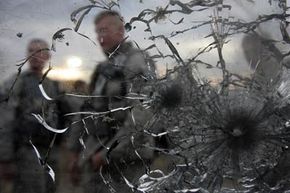The Future of Transparent Aluminum Armor
Over time, a regular pane of bullet-resistant glass will be worn away by windblown desert sand, not to mention incoming rounds from an assault rifle or shrapnel from roadside bombs. Transparent aluminum armor, on the other hand, is hardier. It stands up to .50-caliber rounds, is less affected by sand and fends off scratches more easily than traditional transparent armor.
If that's the case, why don't we replace the bulkier, less protective glass in use? Cost, for one thing.
Advertisement
With a sense of optimism restrained by economic reality, the U.S. Air Force announced in 2005 the results of a series of tests conducted on the material the previous year. While one affiliated researcher described transparent aluminum armor as being "light-years ahead of glass," he acknowledged that it was expensive and difficult to make in large sizes.
Heating and handling larger sheets of transparent aluminum require a sizable investment in infrastructure. For now, there's enough capacity to create 20-by-30-inch (51-by-76-cm) panes [source: CNRS]. That's large enough for most vehicular door windows but too small for front windshields. However, the cost of using these panes to replace existing glass is prohibitive. The bullet-resistant glass currently in use costs around $3 per square inch to produce, a steal compared to the $10 to $15 price tag for the same size piece of transparent aluminum [source: Air Force]. The additional costs of outfitting a vehicle with transparent aluminum armor would, in theory at least, pay for itself over time. Bullet-resistant glass would have to be replaced several times over, while the more expensive material has a much longer life span.
Developed by Raytheon and now commercially marketed by Surmet, transparent aluminum armor, though more expensive than bullet-resistant glass, is cheaper than sapphire, with which it shares common qualities, such as similar degrees of hardness and clarity. Sapphire is used in many different applications, such as semiconductors and bar code sensors, due to its ruggedness. As more industries switch to transparent aluminum for these needs, the price of production could drop to a point that makes it more feasible to build facilities capable of creating larger pieces.
While research continues on the development of this potentially life-saving material, armor-piercing .50-caliber rounds will continue making a mockery of standard bullet-resistant glass both on and off the battlefield.
Shoot on over to the next page for lots more information on bullets, bombs and bad guys.
Related HowStuffWorks Articles
- How Does "Bulletproof" Glass Work?
- What makes glass transparent?
- How Military Snipers Work
- How Body Armor Works
- How Liquid Body Armor Works
- How Blast-resistant Clothing Works
- How Exoskeletons Will Work
- How Machine Guns Work
- How Rocket-Propelled Grenades Work
- How Force, Power, Torque and Energy Work
- How Future Combat Systems Will Work
- How Smart Bombs Work
- How Rail Guns Work
More Great Links
Sources
- AM General. "A Word about Armor Protection." 2008. (July 19, 2008) http://www.amgeneral.com/vehicles_hmmwv_models_armor.php
- Ashley, Steven. "Enhanced Armor." Scientific American. May 15, 2006. (July 19, 2008) http://www.sciam.com/article.cfm?id=enhanced-armor
- Barrett Firearms. "Frequently Asked Questions." 2006. (July 19, 2008) http://www.barrettrifles.com/faq.aspx
- Brady Campaign to Prevent Gun Violence. "Selling High-powered Military Weapons in the Suburbs." 2008. (July 19, 2008) http://www.bradycampaign.org/facts/issues/?page=50cal
- CNRS. "Recent advances in ALON™ optical ceramic." Wahl, Joseph M.; Hartnett, Thomas M.; Goldman, Lee M.; Twedt, Richard and Warner, Charles. 2007. (July 20, 2008) http://cat.inist.fr/?aModele=afficheN&cpsidt=17833350
- Cooke, Gary W. "Gary's U.S. Infantry Weapons Reference Guide: .50 Caliber Browning (12.7 x 99 mm) Ammunition." Nov. 14, 2004. (July 19, 2008) http://www.inetres.com/gp/military/infantry/index.html#mg
- Dorneanu, Lucian. "How Do Armor Piercing Bullets Work?" June 1, 2007. (July 19, 2008)http://news.softpedia.com/news/How-Do-Armor-Piercing-Bullets-Work-56249.shtml
- Lundin, Laura. "Air Force testing new transparent armor." Air Force Research Link. Oct. 17, 2005. (July 19, 2008) http://www.af.mil/news/story.asp?id=123012131
- Martin, Steven W. "The History of Glass." August 2001. (July 19, 2008) http://www.texasglass.com/glass_facts/history_of_Glass.htm
- "Natural glass." Encyclopædia Britannica. 2008. Encyclopædia Britannica Online. (July 19, 2008) http://www.britannica.com/EBchecked/topic/406237/natural-glass.
- PAS. "Ballistic Glass Clad Laminates." 2008. (July 19, 2008) http://www.pasarmored.com/Ballistic_Glass_Clad.php
- PPG Industries. "A Historical Look at Glass: The History, Its Nature, and Its Recipe." 1999 (July 20, 2008) http://www.glasslinks.com/newsinfo/histppg.htm
- Raytheon. "Raytheon and Surmet Corp. to Develop and Market New Aluminum Oxynitride (ALON(R)) Products for Commercial, Defense and Homeland Security Applications." July 25, 2002. (July 19, 2008) http://www.prnewswire.com/cgi-bin/micro_stories.pl?ACCT=683194&TICK= RTN4&STORY=/www/story/07-25-2002/0001771721&EDATE=Jul+25,+2002
- Reade. "READE Offers: Aluminum Oxynitride (ALONTM) Al23O27N5 Powder." (July 19, 2008) http://www.reade.com/index.php?option=com_content&task=view&id=5259&Itemid=10&>
- Ryan, Claudine. "Lightweight, metal-like glass examined." ABC Science Online. June 23, 2008. (July 19, 2008) http://dsc.discovery.com/news/2008/06/23/glass-metal-atoms.html
- Stormforce Pictures. "How to make fake glass." (July 19, 2008) http://www.stormforcepictures.com/howto-makefakeglass.php
- Surmet. "Advanced Ceramics." 2005. (July 19, 2008) http://www.surmet.com/ceramics.html
- "Suspect Organizations and Individuals Possessing Long-Range Fifty Caliber Sniper Weapons." Minority Staff Report; Committee on Government Reform, U.S. House of Representatives. Aug. 17, 1999. (July 19, 2008) http://64.233.167.104/search?q=cache:nlEMxiyt9cwJ:oversight.house.gov/ documents/20040830103758-73537.pdf+%22fifty+caliber%22+%22coast+ guard%22+%22fidel+castro%22&hl=en&ct=clnk&cd=1&gl=us
- "Tungsten carbide." Encyclopædia Britannica. Encyclopædia Britannica Online. 2008. (July 19, 2008) http://www.britannica.com/EBchecked/topic/609104/tungsten-carbide
- U.S. Marine Corps, Department of the Navy Warfaring Publication 3-35.3, Military Operations on Urbanized Terrain, Appendix B, "Employment and Effects of Weapons." smallwarsjournal.com/documents/mcwp3353.pdf
- Violence Policy Center. "Information on 50 Caliber Anti-Armor Sniper Rifles." 2001. (July 19, 2008) http://www.vpc.org/50caliber.htm
